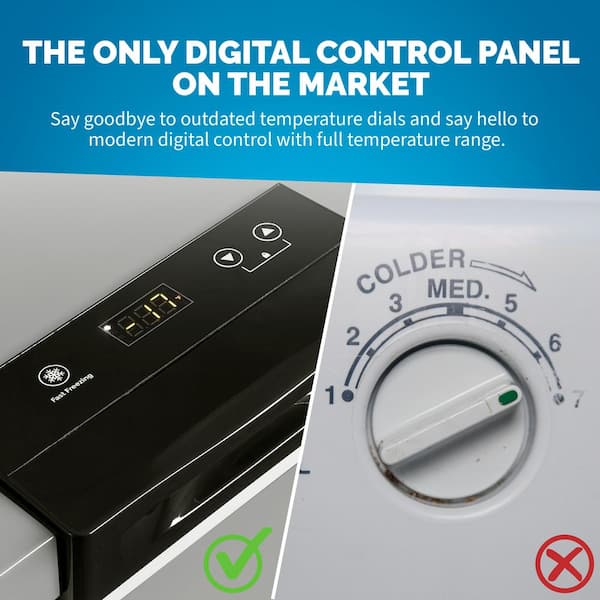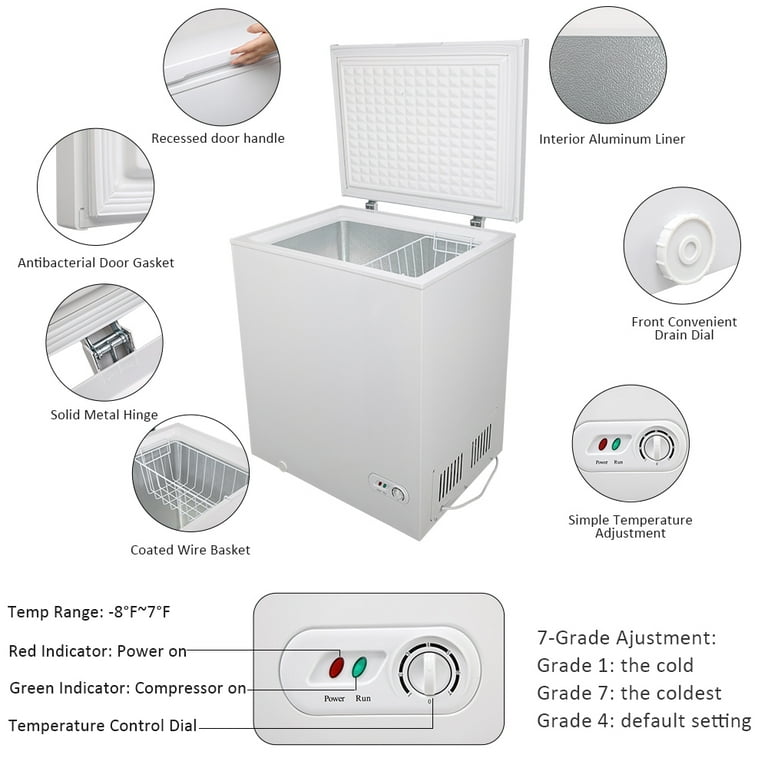Chest freezers typically operate between -10°F and -20°F. This temperature range ensures food remains safely frozen for long-term storage.
Chest freezers are indispensable for households and businesses needing extra storage for frozen goods. These appliances maintain a consistent low temperature, crucial for preserving the quality and safety of food. Setting the temperature correctly is vital to prevent spoilage and ensure energy efficiency.
Most chest freezers come with adjustable thermostats to achieve the desired temperature. It’s essential to monitor and maintain the freezer’s temperature to extend the life of stored items. Regularly checking the freezer’s temperature helps in avoiding potential issues. Proper usage of chest freezers can significantly enhance food storage solutions, making them a valuable addition to any kitchen or commercial setting.
Importance Of Chest Freezer Temperature
Chest freezers keep food fresh. Cold temperatures slow down bacteria growth. Food tastes better and lasts longer. Meat, vegetables, and fruits stay nutritious.
Proper temperature keeps texture and flavor. Ice cream stays creamy, not icy. Vegetables stay crisp, not mushy.
Chest freezers stop food from spoiling. Low temperatures make bacteria inactive. Less spoilage means less waste.
Maintaining the right temperature is key. Not too warm, not too cold. Check the freezer settings often.
Optimal Temperature Settings
Chest freezers should be set between 0°F and -10°F. This range keeps food frozen and safe. Keeping the temperature stable is important. Fluctuations can spoil food.
Room temperature affects freezer performance. Hotter rooms make freezers work harder.
Frequent door opening can raise the temperature. Keep the door closed as much as possible.
Filling the freezer too much can block air vents. This stops cold air from circulating.
Adjusting The Temperature
Set the thermostat between -10°F and 0°F. This range keeps food frozen and safe. Check the freezer temperature regularly. Adjust the dial if needed. Keep the freezer away from heat sources. Ensure the door seals tightly. Proper settings maintain food quality and safety.
Adjust the temperature in summer and winter. In summer, set it a bit colder. In winter, keep it slightly warmer. This helps the freezer work efficiently. Always monitor the temperature with a thermometer. Make small changes based on the season. Proper adjustments save energy and keep food fresh.

Credit: www.homedepot.com
Monitoring Temperature Consistency
A reliable thermometer is essential for chest freezers. Place one inside the freezer to check the temperature. Make sure it shows the correct temperature range. It should be between -18°C and -23°C. This helps to keep food safe and fresh.
Watch for frost buildup in the freezer. Check if food is soft or melting. These are signs of temperature changes. A consistent temperature keeps food frozen and safe. Always monitor the freezer regularly. This helps to catch problems early.
Impact Of Overloading
Air circulation in a chest freezer is very important. Overloading the freezer can block air flow. This can cause some areas to be warmer. Food in these areas may not stay frozen. Spread items evenly for better air flow. Leave some space between items.
A chest freezer works best when not overloaded. Too many items can make the freezer work harder. This can increase energy use. It can also shorten the life of the freezer. Keep the freezer about three-quarters full. This helps it run efficiently.
Freezer Maintenance Tips
Regular defrosting keeps your freezer running smoothly. Ice build-up can cause problems. Defrost your freezer every six months. This helps maintain the optimal temperature range. Unplug the freezer first for safety. Use a towel to catch melting ice. Wipe the inside with a clean cloth. Let it dry completely before plugging it back in.
Cleaning the coils is essential. Dirty coils make the freezer work harder. This wastes energy and costs more. Use a vacuum or a brush to clean the coils. Do this every three months. Clean coils help your freezer last longer. They also keep the temperature steady.
Power Outage Protocols
Keep the freezer door closed during a power outage. This helps maintain the cold temperature. A full freezer stays cold longer than a half-full one. Food can stay safe for 48 hours in a full freezer. For a half-full freezer, it lasts 24 hours. Use a thermometer to check the temperature. Food is safe if it stays below 40°F.
Consider using a generator to keep the freezer running. Ice packs can also help keep the temperature low. Place them around the food for better results. Dry ice is another option. 50 pounds of dry ice can keep a freezer cold for 2 days. Make sure to handle dry ice with care.

Credit: www.walmart.com
Choosing The Right Freezer
Picking the right size is important. A large freezer may waste energy. A small freezer might not fit all your food. Measure your space before buying. Think about your family’s needs. A bigger family might need a bigger freezer. Smaller families might do with less space.
Energy-efficient freezers save money. Look for the ENERGY STAR label. This means the freezer uses less power. Check the annual energy consumption. It’s shown in kilowatt-hours (kWh). Lower numbers mean less energy use. This helps the environment too.

Credit: www.youtube.com
Frequently Asked Questions
What Is The Ideal Temperature For A Chest Freezer?
The ideal temperature for a chest freezer is 0°F (-18°C). This ensures food stays frozen and safe for long-term storage.
Is 20 Degrees Ok For A Freezer?
No, 20 degrees Fahrenheit is too warm for a freezer. Freezers should be set at 0 degrees Fahrenheit for optimal food preservation.
Is 1 Or 7 Colder On A Chest Freezer?
On a chest freezer, 7 is colder than 1. Higher numbers indicate lower temperatures. Adjust accordingly for optimal freezing.
What Is The Correct Temperature Range For A Freezer?
The correct temperature range for a freezer is -18°C to -20°C (0°F to -4°F). This keeps food safe and preserves quality.
Conclusion
Maintaining the right temperature in your chest freezer ensures food safety and longevity. Set it between -10°F and 0°F. Regularly monitor and adjust as needed. Proper temperature management helps prevent spoilage and saves energy. Keep these tips in mind for optimal freezer performance and food quality.
